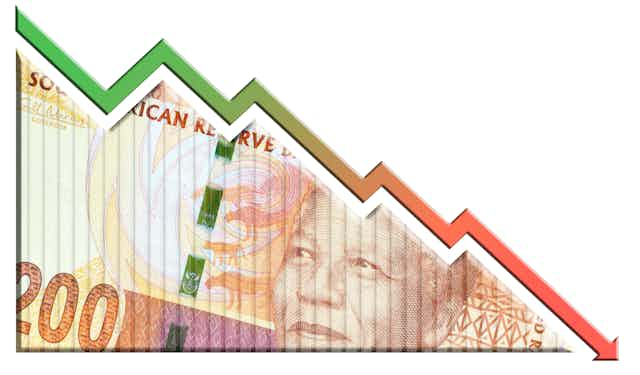Although South Africa avoided a downgrade to non-investment grade, or junk status, in 2016, the country is not yet out of the woods and may be downgraded this year. The reasons for this are ongoing political risk as factional battles in the governing African National Congress intensify, policy inconsistencies and low economic growth.
The effects of a sovereign credit rating downgrade would be significant for all South Africans. It would drive up borrowing costs, which in turn would have a negative impact on the government’s finances. It could also lead to foreigners leaving South Africa’s capital markets as well as driving the rand weaker. And it would in-turn push interest rates up, which would hurt ordinary South Africans.
But there are some possible steps the country can still take to avert a downgrade. These would include underscoring that Finance Minister Pravin Gordhan is secure in his job, and cutting wasteful expenditure.
Impact on the markets
South Africa’s public debt stands at 50.1% of the country’s GDP, nearly double what it was in 2006. If the government’s borrowing position is not controlled it runs the risk of running up debts that it can’t service. An over-borrowed government is also perceived to be risky, which increases the cost of additional borrowing because lenders demand a premium. On top of this the country’s fiscus is under pressure from low revenue collection as a result of the slowing economy.
A downgrade to junk status is also likely to trigger significant capital flight. This is because sovereign downgrades typically have a direct impact on bonds and other fixed income securities making them less attractive to foreign bond investors. The likely outcome is that they will take their money to markets that offer better returns. This would be bad news for the country as foreign investors hold about R62 billion (USD4.5 billion) in government securities.
A downgrade may not affect equity holders to the same extent as bondholders. Of the 472 companies listed on the Johannesburg Securities Exchange, 39 are dual listed. These have primary or secondary listings in South Africa, London and New York. Companies listed abroad will be less vulnerable because most of their earnings are from abroad and in foreign currencies. But companies listed solely in South Africa would be affected by the country’s poor economic performance and a weaker currency. This is likely to drive them to internationalise which would mean a loss to South Africa. In addition, their valuations would be negatively affected by the higher cost of capital.
As the bond market reacts to the sovereign downgrade, the ripple effect would extend to the rand, causing it to weaken against other major currencies. The rand averaged R14/USD at the end of 2016 but a downgrade this year would be likely to push it beyond its lowpoint of about R16.80/USD, possibly beyond the R20/USD level in the medium term). It plunged to this level in December 2015 after President Jacob Zuma announced he was removing then Finance Minister Nhlanhla Nene.
Ordinary people
According to the World Bank South Africans are the biggest borrowers in the world. The country’s National Credit Regulator Statistics has reported that approximately 20% of consumers are three months in arrears.
A Adowngrade would drive up debt servicing costs. In addition, the fiscus would be under pressure due to higher interest costs on debt repayments coupled with lower economic growth. The government’s response would then be to raise taxes. The choices would between the politically unpalatable option of raising the value added tax rate, which would hit the rural poor and the lower-middle class urban consumers, or increasing personal taxes on the already over-taxed working middle class. As the recent local government elections have shown this could also have political ramifications for the governing party.
With budget deficits for the past 20 years averaging -3.24%, a rating downgrade would force the government to either embark on injecting new money into the economy or borrowing more. Injecting new money into the economy would fuel inflation and exert pressure on the exchange rate. The central bank would then have to respond by raising interest rates, again hitting consumers.
Further borrowing is also risky as it could lead to a possible debt trap where the government is no longer able to service its debts.
Momentous year
This is a momentous year for the country, with the factional battles and ANC contestation gathering momentum, and for the world with the inauguration of President Donald Trump and uncertainties around post-Brexit trade policies. In such an uncertain environment, South Africa must rectify the four mistakes that have led it to drift to the point of a downgrade.
First, government policy needs to be clear, consistent and growth-oriented. Second, rather than considering further borrowing or increasing taxes, the government must cut non-productive spending and restructure the non-viable state-owned entities (especially those that rely on bailouts or have become too large to manage). Third, the authorities need to ensure that business confidence doesn’t deteriorate further. It can do this by desisting from issuing conflicting political statements which cause investors to panic. And lastly, the presidency must quell the uncertainty around the finance minister’s position.
If South Africa continues to get these wrong, it’s likely that it will be downgraded this year. Since it takes an average of seven years for a country to regain its investment grade, South Africa would be stuck in a middle-income trap until at least 2024. Under this scenario it would be unable to move out of low-level manufacturing, unemployment levels would remain high and the economy would remain stagnant.

